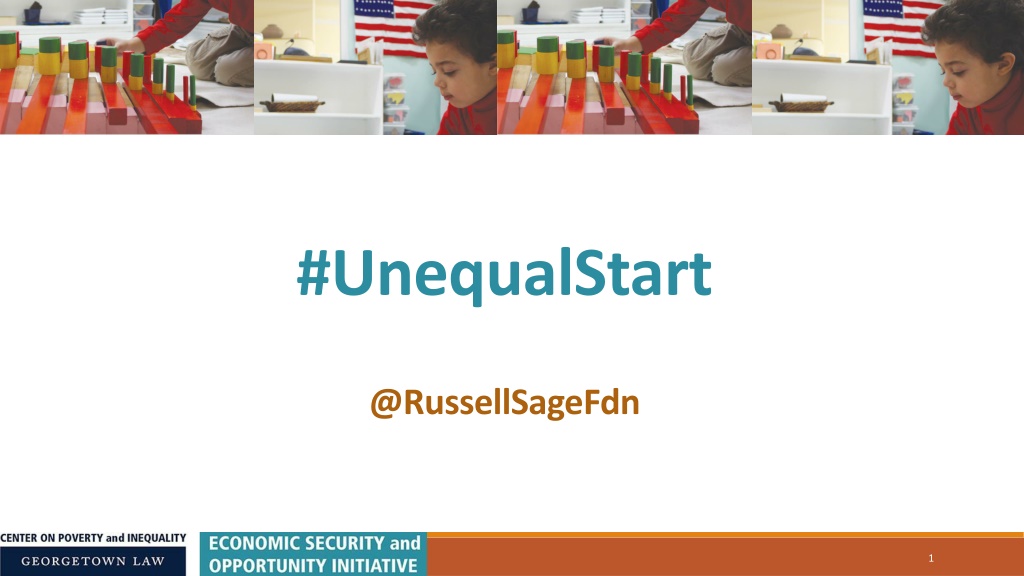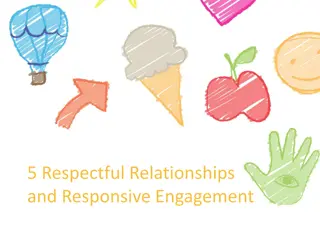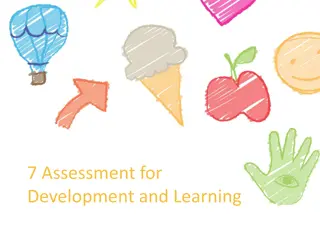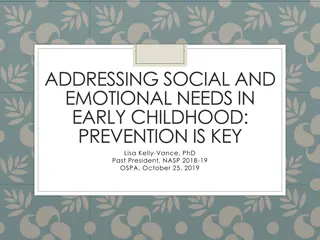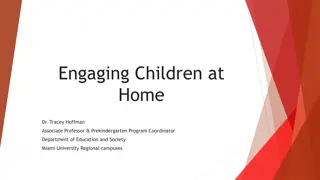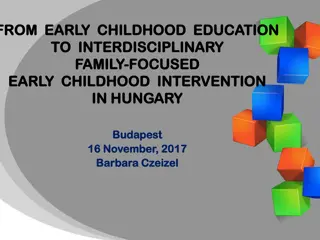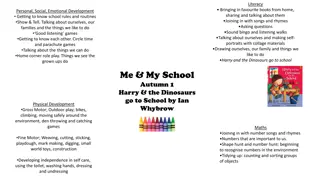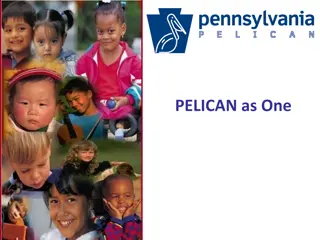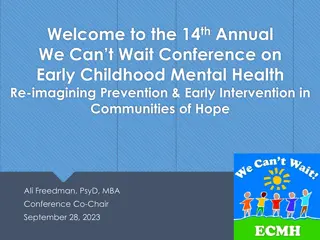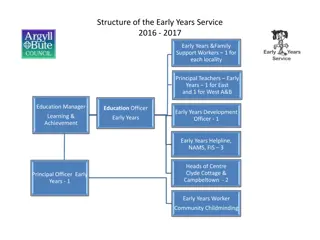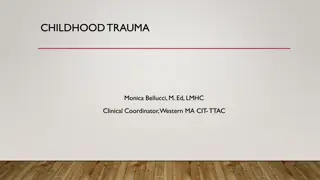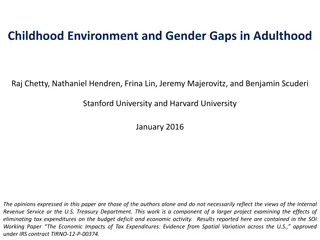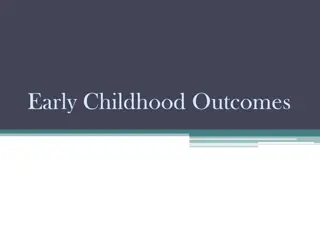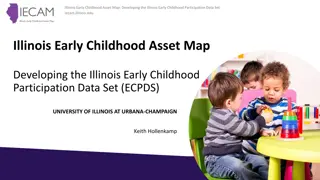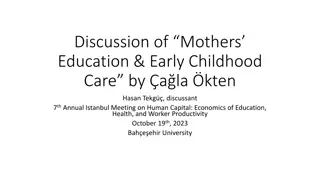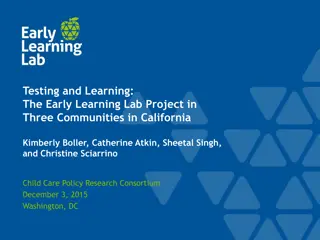Insights on Early Childhood Development in the U.S.
Comprehensive insights on the state of early childhood development in the U.S., highlighting challenges, income gaps, educational investments, and the importance of high-quality interventions.
Download Presentation

Please find below an Image/Link to download the presentation.
The content on the website is provided AS IS for your information and personal use only. It may not be sold, licensed, or shared on other websites without obtaining consent from the author.If you encounter any issues during the download, it is possible that the publisher has removed the file from their server.
You are allowed to download the files provided on this website for personal or commercial use, subject to the condition that they are used lawfully. All files are the property of their respective owners.
The content on the website is provided AS IS for your information and personal use only. It may not be sold, licensed, or shared on other websites without obtaining consent from the author.
E N D
Presentation Transcript
#UnequalStart @RussellSageFdn 1
Cradle to Kindergarten: Cradle to Kindergarten: A New Plan to Promote All Children s Development Ajay Chaudry, Taryn Morrissey, Christina Weiland, and Hirokazu Yoshikawa BRIEFING APRIL 24, 2017 GEORGETOWN CENTER ON POVERTY AND INEQUALITY & U.S. SENATE HELP AND FINANCE COMMITTEES
Take aways 1. Most children in the U.S. are not entering school ready to learn. 2. Income gaps in achievement and development are very large and begin early. 3. Income gaps in families accessto and the quality of early learning opportunities are large and growing. 4. The earliest years are the most promising period for brain and skill development, yet it is when the U.S. invests the least. 5. Greater investments in a cohesive vision of high-quality early childhood interventions can promote improved, more equitable development and give all children a level playing field. 3
Selected school readiness skills for children ages 3 to 6, by parent education. Source: 2012 (NHES) 4
Estimated trends in test performance by family income level, age 13. Source: (Reardon) 5
Average cognitive and achievement skill impact at the end of preschool program treatment. Average cognitive impact at end of treatment Average cognitive impact at end of treatment 2.00 Average effect size in standard deviation Perry Preschool 1.50 Abecedarian Boston pre-K 1.00 units National HeadStart 0.50 0.00 1955 1960 1965 1970 1975 1980 1985 1990 1995 2000 2005 2010 2015 -0.50 Source: Magnuson & Duncan, 2016, The Russell Sage Foundation Journal of the Social Sciences 6
Educational investments in the early years have greatest benefit but we do too little. Federal and State/Local Spending on Children, by age Average per child annual public expenditure for education in U.S. $12,400 Federal State $10,430 $4,579 $1,277 $4,138 $4,023 $1,350 $3,723 Ages 0-2 Ages 3-5 Ages 6-17 Before K K-12 Source: Kena et al. 2016 Source: Edelstein et al. 2013 7
U.S. workers lack access to paid family leave especially lower income workers. Private sector workers 13% Workers in the top quarter of earnings 21% Workers in the middle two quarters of earnings 11% Workers in the bottom quarter of earnings 5% 0% 5% 10% 15% 20% 25% Source: US DOL Bureau of Labor Statistics Leave benefits: Access, National Compensation Survey,March 2014 8
Large disparities by family income in use of early learning programs, especially for youngest children. Rates of center-based ECE for infants and toddlers, by family income and child age, 2011 50% 45% 40% 35% 31% 31% Low-income (0-200% FPL) 30% 25% Moderate-income (200-400% FPL) 19% 20% 17% 16% Middle- and Higher- income (400%+ FPL) 15% 11% 8% 10% 7% 6% 5% 0% Under age one Age 1 Age 2 Source: Chaudry, Morrissey, Weiland, and Yoshikawa (2017) (2008 SIPP Panel Data) 9
Children from low-income families experience lower quality, as well as less access. Emotional Support (CLASS) Instructional Quality (CLASS) Overall quality (ECERS) 0.00 -0.10 Effect size (relative to 5th Quintille) -0.20 1st quintile -0.30 2nd quintile -0.40 3rd quintile 4th quintile -0.50 -0.60 -0.70 -0.80 Source: Chaudry, Morrissey, Weiland, Yoshikawa (2017) 10
Cradle Cradleto Kindergarten: to Kindergarten: A new plan for high-quality early childhood interventions that gives all children a fair shot. Paid parental leave as social insurance for children and working parents. Reliable guarantee of child care assistance for working families to assure all children can access good, stable early care and learning opportunities. Universal early education that starts at age three. Re-imagine Head Start to begin early and provide continuous development services to the most vulnerable children until school entry 11
Paid parental leave Current Context Our Proposal FMLA provides only unpaid leave at the birth of a child. Only 60 percent of workers are eligible, and far fewer can afford to take unpaid time when also facing added costs to families of a new baby. U.S. just 1 of 2 among 170 countries with no guarantee of paid leave. 13% of private sector workers currently have access to paid family leave, and just 1 in 20 lower wage workers do. A few states have established paid leave programs (California, New Jersey, Rhode Island, New York in 2018) Paid parental leave to guarantee families with working parents 12 to 16 weeks per family of partially paid, job- protected leave at birth or adoption of a child. Families decide how to split weeks of leave with bonus if both parents take some period. Parents get a percentage of their wages during the weeks each is on leave up to a maximum benefit. Administer as social insurance through Social Security system. Recognize being born and having a child are common experiences like old-age or disability for which we can and should insure economic security. 12
Affordable High-Quality Care and Education Current Context Our Proposal Good child care is a basic need for working parents, but it is very expensive and hard to find. Assurance subsidies support costs of high-quality care and education for low- and moderate-income working families with children under age 5 Family incomes below 250% FPL & state option to go to 400% FPL. Family make co-payments on sliding scale, contributing 3- 10% of income. Subsidies adequate to pay for quality. Only licensed care eligible for subsidies. Increased, refundable child care tax credit Tax credit for proportion of paid costs for all types of paid care (licensed and unlicensed). Maximum benefit increased to $3000 for one child. Families with children under 5 spend 11% of incomes on child care. Families with incomes below 200% FPL spend 22%. 15% of eligible families with children receive child care subsidies through Federal and State CCDF funding. States establish most program rules which vary by state and are complex for families to navigate. Child care tax credits provide minimal benefits (max $600) and are not refundable. 13
Universal Early Education Our Proposal Current Context Piecemeal system A few states and cities have universal programs for 4 year olds, and some states have none Fewer public programs for 3 year olds Variation across many dimensions (governance, location, hours of services, workforce, quality assessment) in what exists across states Small, discretionary federal grants to encourage further growth and development of state programs. High-quality universal preschool for children aged 3 and 4. Developmentally focused curricula and professional development Consistent structural quality standards across the system with regular and transparent measurement of process quality. Full school-day and longer school year, with wrap- around care options to meet family needs Mixed auspice (in schools and community centers) Alignment with K-3 education 14
A New Head Start Begins at (or before) Birth Current Context Our Proposal Beneficial program aimed at most disadvantaged, but serves fraction of eligible ~40% in Head Start ~4% in Early Head Start What happens in the context of universal preschool? Target the most vulnerable young children with services starting before or at birth: Communities of concentrated poverty. Poor families and those facing particularly adverse circumstances (e.g., foster care). Integrate center-based early learning with home visiting and other comprehensive services. Head Start centers as hubs to link with child health and other service providers (e.g., WIC, Medicaid/CHIP). Generate innovations in birth to age 3 services and test program elements to further improvise systems. 15
A 10-year investment plan Program Cost at full implementation (in billions) Existing Funding (in billions) New Investments (in billions) Paid parental leave $19.0 Few state programs (including, TDI) and private employers $19.0 Child Care Assurance Child & Dependent Care Tax Credit $30.2 $13.9 $16.3 State Universal Preschool for 3 and 4 year-olds $33.0 $6.2 (states) $26.8 A New Head Start for Infants and Toddlers $17.2 $9.0 $8.2 Total New Public Investments (federal and state) $70.3 16
Conclusions Coordinated investments to develop early childhood services infrastructure from birth to age five Builds on evidence of what works and how to support quality elements that matter for children s developmental outcomes Invests in providing broader access to all children and higher quality provision Flexible for family needs Economic support during period that families bear the brunt of raising children and when foundational brain architecture is vulnerable to disadvantage Shared federal and state responsibility implications for both levels of policy 17
#UnequalStart @RussellSageFdn 18
